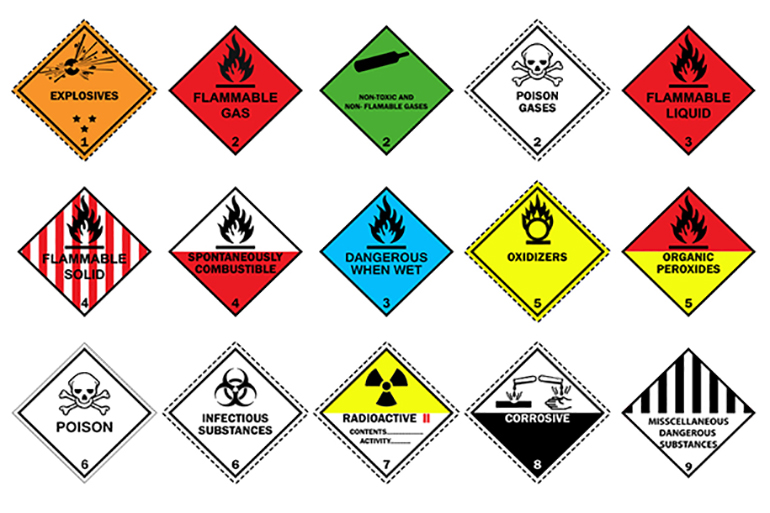
What is needed to make your dangerous shipments move smoothly and eliminate as many hassles as possible?
Table of Contents
Dangerous or hazardous goods are substances that when transported are a risk to health, safety, property or the environment. By identifying dangerous and hazardous goods you are taking the first step in order to reduce the risks connected. Further steps include proper packaging, handling and transportation.
MyDello takes the stress out of global shipping. Instantly compare options across hundreds of shipping providers to find the best possible solution for your shipping needs. Visit MyDello to get an instant quote.
Create Your No-Cost Account Today and experience the New Era of Logistics
A good starting point for determining if your products might be dangerous is by obtaining a Material Safety Data Sheet (MSDS) from the manufacturer and checking the “Transportation Information.” By doing so, you will receive valuable information on the risks related to handling the products you are shipping.
Dangerous and hazardous goods are divided into nine classes that describe different types of risks.
Class 1 items are divided into six subdivisions that describe the potential hazard posed by the explosive. They cover substances that have an explosion hazard, explosions that may project fragments and firebrands, and fire hazards. The movement of class 1 materials is tightly regulated.
Class 2 items include all gases which are compressed and stored for transportation and are divided into three divisions: Flammable (also called combustible), Non-Flammable/Non-Poisonous, and Poisonous. This classification is based on the United Nations Recommendations on the Transport of these Goods – Model Regulations.
Class 3 comprises liquids or mixtures of liquids that have a flash point of not more than 60 °C (140 °F), or any material in a liquid phase with a flash point at or above 37.8 °C (100 °F) that is intentionally heated and offered for transportation or transported at or above its flash point in bulk packaging. The flash point is the minimum temperature at which a liquid gives off vapour within a test vessel in sufficient concentration to form an ignitable mixture with air near the surface of the liquid.
Flammable solids are any materials in the solid phase of matter that can readily undergo combustion in the presence of a source of ignition under standard circumstances, i.e. without Flammable solids are divided into three subdivisions that include highly flammable solids, solids that are likely to spontaneously and substances that, if they come into contact with water, emit flammable gases.
An oxidizer is a chemical that readily yields oxygen in reactions, thereby causing or enhancing combustion. This class is divided into two subdivisions and covers agents that react with oxygen and organic pesticides.
Poisonous material is a material, other than a gas, known to be so toxic to humans that it presents a health hazard during transportation. It is divided into two subdivisions and includes substances such as cyanide, arsenic, vaccines and pathology specimens.
Radioactive substances are materials that emit radiation.
Class 7 covers materials that have a specific activity greater than 70-kilo becquerels per kilogram.
A corrosive material is a liquid-or-solid material that causes full-thickness destruction of human skin at the site of contact within a specified period of time. Corrosive items include battery acids, sulfuric acid and mercury. When shipping corrosives, care should be taken to ensure that incompatible corrosive materials cannot become mixed, as many corrosives react very violently if mixed.
https://www.faa.gov/hazmat/what_is_hazmat/
A miscellaneous hazardous material is a material that presents a hazard during transportation but which does not meet the definition of any other hazard class. This class includes:
Note: Refer to the dangerous or hazardous goods transportation regulations of the country of interest.
https://www.chemsafetypro.com/Topics/TDG/Class_9_Goods.html

Goods that pose a possible risk have different rules when it comes to quantities. If you are shipping samples of any goods that might be considered dangerous, there are some options to move the goods in Excepted Quantities (no additional documents or full set of labels needed), Limited Quantities (labels, declarations needed, no certified packages needed) or Normal Quantities (Full set of documents, labels and packages needed). Shipping as small samples (Excepted or Limited Quantities) might give you an advantage in shipping costs and opportunities to move the goods. What is regarded as Excepted, Limited and Normal quantities might be depending on the certain classification of the dangerous or hazardous goods.
https://www.gov.uk/shipping-dangerous-goods/transporting-limited-quantities
When dangerous goods are shipped, it requires proper packing. Some dangerous and hazardous goods require certified boxes and tapes that have proper markings. For example, regular plastic or painter’s tape might not be sufficient and armed tape is needed. In addition to packaging, proper labelling is needed. All boxes that contain these classification of goods need to have respective labels on them. Also, if the boxes are placed on a pallet and shrink-wrapped, additional labelling is needed on top of the shrink-wrap.

These goods require special safety-focused handling and transportation. Various regulatory authorities control the transportation of hazardous goods internationally and nationally. Some of the most common frameworks for transportation include the United Nations Recommendations on the Transport of Dangerous Goods, the IMO’s International Maritime Dangerous Goods Code, IATA’s Dangerous Goods Regulations and ICAO Technical Instructions.
Dangerous goods usually require a separate declaration, which describes the products in detail. Before filling out the declaration, make sure you consult with your forwarder or carrier. Responsibility for packaging and declarations is generally the shipper’s responsibility, but professional forwarders or advisors usually have experience and are able to help.
When the hazardous cargo is shipped the carriers will ask for a Material Safety Data Sheet, which is known as MSDS. This data sheet must contain full information regarding the product being shipped. MSDS is very important for the carriers to consider acceptance of the product onto the vessel. It basically provides the instructions and the full requirements for handling this dangerous cargo and it must be created by the manufacturer of the product as they would have full information on the item.
MSDS is intended to provide workers and emergency personnel with procedures for handling or working with that substance in a safe manner and includes information such as physical data (melting point, flash point, boiling point, etc.), disposal, toxicity, reactivity, health effects, first aid, protective equipment, and spill handling procedures. Most developed countries have similar regulations and requirements however MSDS formats can vary from source to source within a country depending on national requirements.
The International Civil Aviation Organization (ICAO)has developed dangerous goods regulations for air transport of hazardous materials that are based upon the UN model but modified to accommodate unique aspects of air transport. Individual airline and governmental requirements are incorporated with this by the International Air Transport Association to produce the widely used IATA Dangerous Goods Regulations (DGR).
https://www.iata.org/en/programs/cargo/dgr/faq/
Similarly, the International Maritime Organization (IMO) has developed the International Maritime Dangerous Goods Code (“IMDG Code”, part of the for transportation of dangerous goods by sea. IMO member countries have also developed the to provide compensation in case of spills in the sea.
The Intergovernmental Organisation for International Carriage by Rail (OTIF) has developed regulations concerning the International Carriage of Dangerous Goods by Rail (“RID”, part of the Convention concerning International Carriage by Rail. Many individual nations have also structured their transportation regulations to align with the UN Model in the organization as well as in specific requirements.
The Globally Harmonized System of Classification and Labelling of Chemicals (GHS) is the internationally agreed-upon system set to replace the various classification and labelling standards used in different countries. The GHS uses consistent criteria for classification and labelling on a global level.
We all need a little advice sometimes, especially in an industry as complex as logistics, give us a call and benefit from MyDello’s years of experience.
In general, shipping of these goods are more expensive and time-consuming. It’s reflected well in the shipping & packaging costs. Nevertheless, with proper planning and discussions with your forwarder, he or she can help you to make it happen – smoothly, safely and surely! MyDello logistics specialists can help you out.

